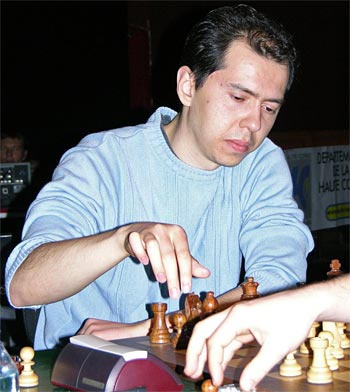| Latest | Greatest | Lobby | Journals | Search | Options | Help | Login |
|
|
|
This topic is archived. |
| Home » Discuss » Topic Forums » Sports |
|
| Jack Rabbit
|
Sun Nov-12-06 03:11 AM Original message |
| Jack Rabbit Chess Report for November 12: Hippopotamus Edition |
|
Edited on Sun Nov-12-06 03:17 AM by Jack Rabbit
The Jack Rabbit Chess Report for the week ending November 12  Contents Post 1: News for the week Post 2: Diagrams and other features Post 3: Games from Current and Recent Events Post 4: The Hippopotamus Game: Mikhail Tal - Evgeny Vasiukov, Soviet Championship, Kiev, 1965 |
| Printer Friendly | Permalink | | Top |
| Jack Rabbit
|
Sun Nov-12-06 03:11 AM Response to Original message |
| 1. News for the week ending November 12 |
|
Kasimdzhanov wins Corsica Masters' rapid event
 Grandmaster Rustam Kasimdzhanov of Uzbekistan won the tenth annual Corsica Masters' Tournament, a rapid Knock out event, by defeating the world's premiere master chess, Indian grandmaster Viswanathan Anand, in the final two-game match in Bastia, on the northeastern tip of the Mediterranean island of Corsica (France) last Sunday. Kasimdzhanov earned the right to face Anand by defeating French grandmaster Etienne Bacrot in the Semi-Final. Earlier this month, Bacrot was a quarter-finalist in another prestigious rapid event, the Cap d'Agde Masters'. Meanwhile, Anand defeated Murtas Kazhgaleyev of Kazakhstan in his semi-final match. In the first game of the final match, Kasimdzhanov scored a fine victory as Black (see below). The second game ended in a draw. Kasimdzhanov, the 36th ranked player in the world according to the latest ratings at conventional chess, is now one the best in the world at rapid chess. Next summer, he will play Anand for the title of world rapid chess champion at the Mainz Chess Festival. Anand has successfully defended the title annually for seven years. This is the first time Kasimdzhanov has won the Corsica Masters'; Anand has won the event five times. Ponomariov leads Tal Memorial after five rounds.  Ukrainian grandmaster Ruslan Ponomariov is leading the Tal Memorial Tournament in Moscow after five rounds with 3½ points. Tied for second place with 3 points each are Levon Aronian of Armenia, Peter Svidler of Russia and Peter Leko of Hungary. Among the leaders, Ponomariov and Aronian have scored two wins each. However, Ponomariov has drawn his other three games, while Aronian has two draws and one loss. Svidler and Leko each have one victory and four draws. Ponomariov has had a rough year on the international circuit. As recently as a year ago he was ranked in the top ten; a series of poor results this year have dropped him to 20th. Aronian has had an up-and-down year in which he won at Linares in March and was ranked third, but then had a disappointing result at Dortmund in July. He is currently ranked seventh. |
| Printer Friendly | Permalink | | Top |
| Jack Rabbit
|
Sun Nov-12-06 03:12 AM Response to Original message |
| 2. Diagrams and other features of the JR Chess Report |
|
!""""""""# $tMvWlVmT% $OoOoOoOo% $ + + + +% $+ + + + % $ + + + +% $+ + + + % $pPpPpPpP% $RnBqKbNr% /(((((((() White to move This position is a theoretical draw Does this picture make sense to you? If not, or if it looks like a bunch of Wingdings, please click here. Diagrams used in the Jack Rabbit Chess Report are made with Chess Merida, a true type font that is available as freeware at the above link. |
| Printer Friendly | Permalink | | Top |
| Jack Rabbit
|
Sun Nov-12-06 03:14 AM Response to Original message |
| 3. Games from current and recent events |
|
Edited on Sun Nov-12-06 03:26 AM by Jack Rabbit
Chess Games Analysis by JR and Fritz Levon Aronian - Alexander Morozevich, Tal Memorial, Round 1, Moscow Vishy Anand - Rustam Kasidzhanov, Corsica Masters' Final Match, Round 1, Bastia Sergey Karjakin - Zhao Xue, Masters' Quarter-Finals, Round 1, Cap d'Agde Teimour Radjabov - Sergey Karjakin, Masters' Final, Round 2, Cap d'Agde Ruslan Ponomariov - Alexander Grischuk, Tal Memorial, Round 1, Moscow Levon Aronian - Peter Svidler, Tal Memorial, Round 3, Moscow |
| Printer Friendly | Permalink | | Top |
| Jack Rabbit
|
Sun Nov-12-06 03:18 AM Response to Reply #3 |
| 5. Aronian - Morozevich, Tal Memorial, Moscow |
 Levon Aronian Levon Aronian vs. Alexander Monozevich Tal Memorial Tournament, Round 1 Moscow, November 2006 Queen's Gambit: Hastings Opening (Queen's Gambit Accepted) 1. d4 d5 2. Nf3 e6 3. c4 dxc4 4. e3 a6 5. a4 Nf6 6. Bxc4 c5 7. 0-0 Nc6 8. Qe2 Be7 9. Rd1 Qc7
Black: Alexander Morozevich !""""""""# $t+v+ Tk+% $+ + +oO % $o+ + M +% $+ + + W % $p+bNo+ O% $+ R P Np% $ +q+ Pk+% $+ +r+ + % /(((((((() White: Levon Aronian Position after 24. -- h5h4 25. Bxf7+!!
Black: Alexander Morozevich !""""""""# $ + + +tL% $+ + + Ow% $o+ + + +% $+ + +r+ % $p+ +pRk+% $+ + +n+t% $q+ + + +% $+ + + + % /(((((((() White: Levon Aronian Position after 40. -- Re8g8 41. Qxg8+!
|
| Printer Friendly | Permalink | | Top |
| Jack Rabbit
|
Sun Nov-12-06 03:19 AM Response to Reply #3 |
| 6. Anand - Kasimdzhanov, Corsica Masters', Bastia |
 Rustam Kasimdzhanov To view this game: Please click here. Scroll down the game list to the next-to-last game. Enjoy. Vishy Anand vs. Rustam Kasimdzhanov Corsica Masters' Final Match, Round 1 Bastia, November 2006 Spanish Grand Royal Game: Zaitsev Defense 1. e4 e5 2. Nf3 Nc6 3. Bb5 a6 4. Ba4 Nf6 5. 0-0 Be7 6. Re1 b5 7. Bb3 d6 8. c3 0-0 9. h3 Re8 10. d4 Bb7 11. Nbd2 Bf8 12. a4
Black: Rustam Kasimdzhanov !""""""""# $ + + Vl+% $+v+ +oO % $ + O W O% $+ Mp+ + % $ +n+t+ +% $+ + Rn+p% $ P +qMp+% $+bB + K % /(((((((() White: Vishy Anand Position after 25. Qd1e2 25. -- Nxh3+!!
|
| Printer Friendly | Permalink | | Top |
| Jack Rabbit
|
Sun Nov-12-06 03:20 AM Response to Reply #3 |
| 7. Karjakin - Zhao Xue, Quarter-Finals, Cap d'Agde |
|
Edited on Sun Nov-12-06 03:36 AM by Jack Rabbit
 Sergey Karjakin Sergey Karjakin vs. Zhao Xue Quarter Final Match, Round 1 Cap d'Agde, Languedoc Province (France), October 2006 Spanish Grand Royal Game: Breyer Defense 1. e4 e5 2. Nf3 Nc6 3. Bb5 a6 4. Ba4 Nf6 5. 0-0 Be7 6. Re1 b5 7. Bb3 d6 8. c3 0-0 9. h3 Nb8 10. d4 Nbd7 11. Nbd2 Bb7 12. Bc2 c5 13. d5 c4
Black: Zhao Xue !""""""""# $ T + + L% $T + +o+o% $v+ O PoN% $Oo+pO Bm% $ +o+p+ P% $P Pm+ + % $ P + Pk+% $R +bR + % /(((((((() White: Sergey Karjakin Position after 31. -- Nc5d3 32. Bxh5!!
Black: Zhao Xue !""""""""# $ +v+ T L% $+t+ +o+o% $ + O P N% $Oo+pO +o% $ +o+p+ P% $P P B + % $ P + P K% $+ + + R % /(((((((() White: Sergey Karjakin Position after 36. -- Ra7b7 37. Rg7!
|
| Printer Friendly | Permalink | | Top |
| Jack Rabbit
|
Sun Nov-12-06 03:21 AM Response to Reply #3 |
| 8. Radjabov - Karjakin, Masters' Final, Cap d'Agde |
 Teimour Radjabov Teimour Radjabov vs. Sergey Karjakin Masters' Final Match, Round 2 Cap d'Agde, Languedoc Province (France), November 2006 Open Sicilian Game: Najdorf Defense (Poisoned Pawn Variation) 1. e4 c5 2. Nf3 d6 3. d4 cxd4 4. Nxd4 Nf6 5. Nc3 a6 6. Bg5 e6 7. f4 Qb6
Black: Sergey Karjakin !""""""""# $t+v+ Tl+% $+o+ +oO % $o+ +oB O% $+ V P + % $ + M + +% $W P Q + % $ + +b+pP% $+ +r+rK % /(((((((() White: Teimour Radjabov Position after Nc6xd4 21. Rxd4!
|
| Printer Friendly | Permalink | | Top |
| Jack Rabbit
|
Sun Nov-12-06 03:22 AM Response to Reply #3 |
| 9. Ponomariov - Grischuk, Tal Memorial, Moscow |
 Ruslan Ponomariov Ruslan Ponomariov vs. Alexander Grischuk Tal Memorial Tournament, Round 1 Moscow, November 2006 Queen's Gambit: Slav Defense (Chameleon Variation) 1. d4 d5 2. c4 c6 3. Nc3 Nf6 4. e3 a6 5. Nf3 b5 6. c5 g6 7. Bd3 Bg4!?
Black: Alexander Grischuk !""""""""# $ + + L +% $+ + +o+o% $ +o+tM +% $+ Po+n+ % $o+ P + +% $P K Pt+p% $ + + + +% $+ + + + % /(((((((() White: Ruslan Ponomariov Position after 33. -- Nd7f6 34. Nd6!
|
| Printer Friendly | Permalink | | Top |
| Jack Rabbit
|
Sun Nov-12-06 03:23 AM Response to Reply #3 |
| 10. Aronian - Svidler, Tal Memorial, Moscow |
 Peter Svidler Levon Aronian vs. Peter Svidler Tal Memorial Tournament, Round 3 Moscow, November 2006 West India Game: Indian Queen's Gambit (Grünfeld Defense) 1. d4 Nf6 2. c4 g6 3. Nc3 d5 4. Bg5 Ne4 5. Bh4!?
Black: Peter Svidler !""""""""# $ +t+t+l+% $+o+ +oVo% $ + + +o+% $O + + B % $p+wP + +% $+ +q+ + % $ + + PpP% $R +r+ K % /(((((((() White: Levon Aronian Position after 24. e5xd4 24. -- Re1+ 25. 0-1
|
| Printer Friendly | Permalink | | Top |
| Jack Rabbit
|
Sun Nov-12-06 03:15 AM Response to Original message |
| 4. The Hippopotamus Game: Tal - Vasiukov, Kiev, 1965 |
|
This post incorporates notes from Tal's autobiogaphical game collection, The Life and Games of Mikhail Tal (Ken Neat, trans., Gloucester Publishers, London, 1997). Unless otherwise noted, the quotes are found petween pp. 291-95.
Much of the book is written as an interview by a Journalist of a Chess Player.  Mikhail Tal Mikhail Tal vs. Evgeny Vasiukov Soviet Championship (Final), Round 13 Kiev, January 1965 Open German Game: Steinitz Defense (Caro-Kann Defense) 1. e4 c6 2. Nc3 d5 3. d4 dxe4 4. Nxe4 Nd7
Black: Evgeny Vasiukov !""""""""# $t+ + T L% $O Wm+ Oo% $vO VoO +% $+ +m+ +n% $ +p+b+ B% $+ + +n+ % $pP +qPpP% $+ +r+rK % /(((((((() White: Mikhail Tal Position after 18. -- Bb7a6
Black: Evgeny Vasiukov !""""""""# $ + +tT L% $O + + + % $vO + Oo+% $+ + + + % $ +p+ + B% $+ + + + % $pP + PpV% $+ +rR +k% /(((((((() White: Mikhail Tal Position after 28. -- h7xg6 29. Bxf6+!
|
| Printer Friendly | Permalink | | Top |
| DU
AdBot (1000+ posts) |
Fri Apr 26th 2024, 10:40 AM Response to Original message |
| Advertisements [?] |
| Top |
| Home » Discuss » Topic Forums » Sports |
|
Powered by DCForum+ Version 1.1 Copyright 1997-2002 DCScripts.com
Software has been extensively modified by the DU administrators
Important Notices: By participating on this discussion board, visitors agree to abide by the rules outlined on our Rules page. Messages posted on the Democratic Underground Discussion Forums are the opinions of the individuals who post them, and do not necessarily represent the opinions of Democratic Underground, LLC.
Home | Discussion Forums | Journals | Store | Donate
About DU | Contact Us | Privacy Policy
Got a message for Democratic Underground? Click here to send us a message.
© 2001 - 2011 Democratic Underground, LLC